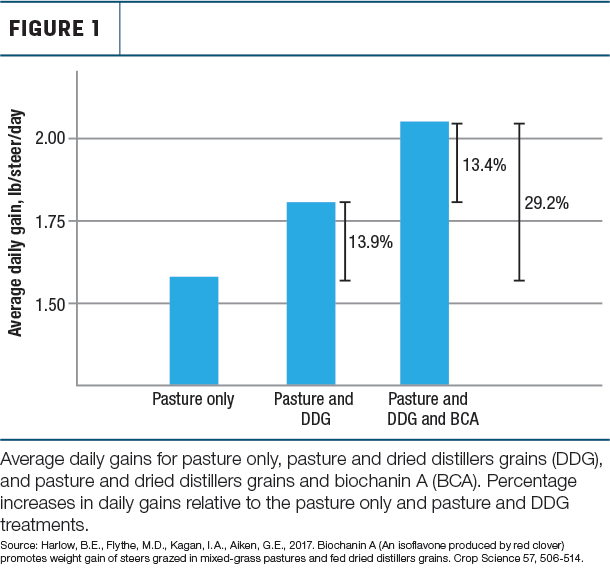As a forage crop agronomist, clover has always been the holy grail. Clover in pastures improves soil condition, supplies nitrogen to companion grasses when recycled back to pasture as manure and urine, increases yield, increases intake of both protein and energy and can eliminate the need for supplemental fertilizer nitrogen (N) when high-yielding legumes like red clover are present in grass pastures.
The dominant clovers in the transition zone of the humid U.S are red and white clovers.
Over the past decade or so, the benefits of red and white clover have been found to extend beyond the agronomic, leading to even more reasons to love red clover. These breakthroughs have come from the collaborative work between the USDA Forage Animal Production Research Unit (FAPRU) and the College of Agriculture Food and Environment at the University of Kentucky.
The first of this work occurred in the middle 2000s, when Michael Flythe and Isabelle Kagan and others from USDA-FAPRU were looking for natural alternatives to the antimicrobial feed additives like monensin and lasalocid. Their use is falling out of favor because of the increased concern they can cause an increase in the occurrence of antibiotic-resistant bacteria.
In laboratory experiments, they found biochanin A, an isoflavone found in red clover, reduces the number of hyper-ammonia-producing bacteria (HAB) in the rumen. These HAB are detrimental because they reduce the amount of protein which passes out of the rumen by removing the amine groups from dietary plant protein. When greater amounts of dietary protein bypass the rumen, cattle performance is improved.
To test the mechanism of isoflavones, scientists at the FAPRU unit looked at the effect of a red clover isoflavone, biochanin A, on steer gains grazing pasture or pasture plus supplement (dry distillers grain). Figure 1 shows that DDG without biochanin A improved average daily gain 13% relative to the pasture-only treatment, but adding biochanin A to the DDG boosted average daily gain 29% compared to the control.

These results confirmed lab findings that adding biochanin A to the protein supplement improved the quality of protein available to the steers.
Along the way, a serendipitous finding revealed another clover “superpower.” These researchers learned from human research that isoflavones can dilate arteries and promote blood flow. Since vasoconstriction is one of the primary physiological effects of the toxic endophyte of tall fescue, an agent which would reverse this effect would be beneficial indeed.
Subsequent work showed isoflavones from red or white clover can in fact reverse the vasoconstrictive effects of toxic tall fescue and improve blood flow. The most recent work has shown the positive effects of isoflavones can be achieved by the dietary levels found in clover pasture or hay.
It is important to understand biochanin A and other isoflavones are phytoestrogens. In high doses, they can mimic the positive and negative effects of estrogens. Consuming large amounts of red clover can lower the fertility of cows and sheep.
Another consideration is how to best deliver the biochanin A to growing steers. Grazing is the obvious choice for many, but a 20% to 40% clover stand (by weight) will likely be necessary to obtain the benefits of clovers on calf performance. This amount of red clover is similar to that needed to eliminate the need to add fertilizer N to pastures and hayfields and maintain yields.
Fortunately, clovers are relatively easy to establish in grass pastures in the late winter or early spring by frost seeding clover seed onto closely grazed or clipped pastures, withholding spring N fertilizer and clipping to manage the grass competition in April and May. Soils should have pH values in the mid to upper 6’s and test medium to high in phosphorus (P) and potassium (K).
Soil test to know your current fertility levels and fertilize accordingly. Be sure to choose varieties adapted to your region which have performed well in replicated yield trials. Research at the University of Kentucky has found improved red clovers can last twice as long and yield twice as much as common seed.
You always knew that clovers in pastures and hay fields were very beneficial to cattle, and new research has shown isoflavones in clover hinder detrimental bacteria in the rumen, increase rumen bypass protein and reverse the vasoconstriction effects of tall fescue. Now you have even more reasons to love clover.









